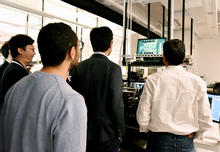Princeton-University of Tokyo Strategic Partnership Celebrates In-Person Collaboration

September, the Princeton-University of Tokyo Strategic Partnership marked what its director James Raymo called “a full-scale resumption of face-to-face collaboration after a long interruption.”
A delegation from the University of Tokyo arrived in New Jersey to reinvigorate a long-running research project between Kaushik Sengupta, associate professor of electrical and computer engineering, and d.lab, a consortium of AI and semiconductor technology companies that work closely with faculty members at the University of Tokyo. The Japanese representatives toured Sengupta’s Integrated Micro-systems Research Lab, met with other Princeton engineering and computer science faculty and discussed a 2023 symposium workshop in Tokyo.
In light of COVID travel restrictions over the past two years, the researchers had created a virtual environment in which they designed and prototyped semiconductor integrated circuits together and pivoted entirely from analog to digital circuit research, explained Tadahiro Kuroda, University of Tokyo professor of engineering. “This is because collaborative analog circuit design is best done while reviewing circuit diagrams and simulation results together. In contrast, by having individual designers set up their own simulation environment, we can use a software-centric methodology to effectively design and verify digital circuits even with limited in-person interaction.”

“We have managed to keep parts of our partnership activities on track via remote collaboration,” — like this specific project — “but this arrangement is fundamentally limiting,” added Raymo, who is a professor of sociology and East Asian studies. For example, Kuroda said, while virtual connection provided opportunities for hardware-oriented students to learn about software technology and for researchers to adopt a more efficient research methodology, the distance made it challenging to share prototype evaluation expertise with students, “which is best done while conducting experiments together.”
The Japanese delegation met not only their collaborators but other faculty as well, said Sengupta: “The visit allowed them to form deeper, interlocking connections with the broader Princeton community.”
Raymo, who is also inaugural director of the newly established Global Japan Lab, which seeks to promote and support research, teaching and training on contemporary Japan across multiple disciplines, looks forward to a robust return of travel and programming — from more such events to conferences to student exchange. “In-person events are of significance,” added Satoshi Watanabe, professor of materials engineering and Raymo’s counterpart at the University of Tokyo. Watanabe stressed that he appreciated the diversity of the Princeton community, which leads to broader networking opportunities and is something “missing in Japan,” he said. “And it is especially fruitful for students who have little international experience.”
While such a return to normal will have a significant impact on research and teaching outcomes, it will also strengthen the sort of connection and community that takes place in the spaces outside classrooms and labs, said Kuroda. “We hope to deepen our relationship and mutual cultural understanding,” he said.
